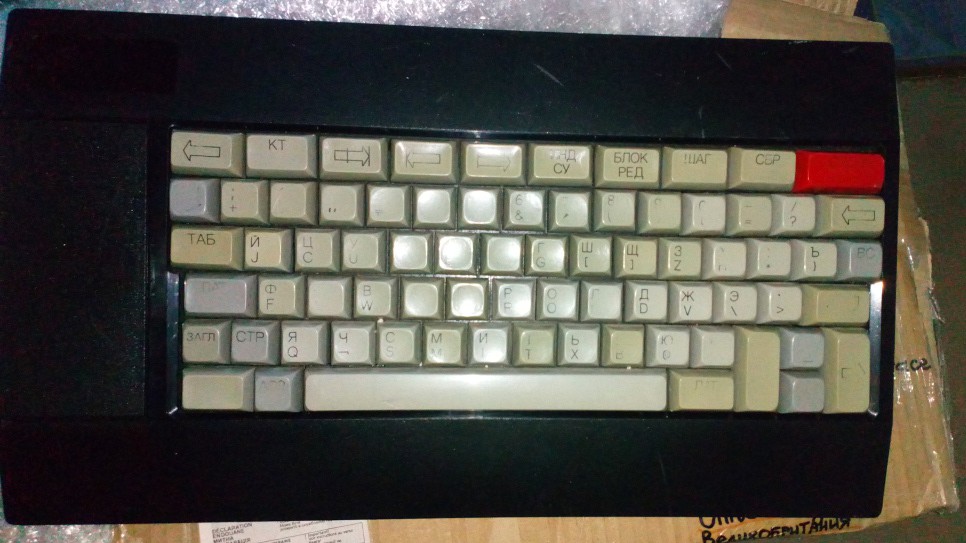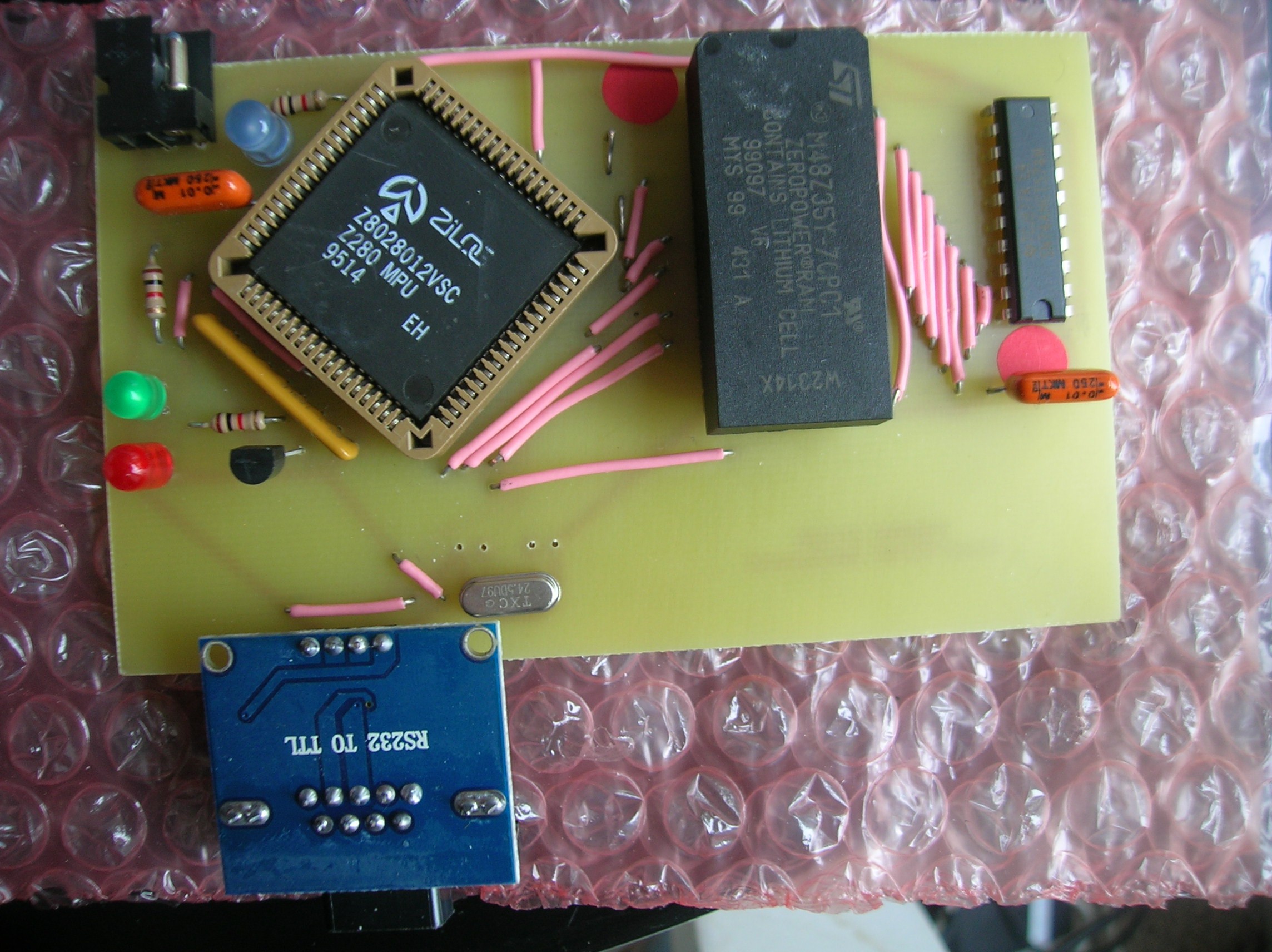![]() would be cool to crowd-fund a proper injection molded case for it
would be cool to crowd-fund a proper injection molded case for it
 @Bil Herd That is true. Had a number of dev jobs for clients based on previous projects and things I've played around with.
@Bil Herd That is true. Had a number of dev jobs for clients based on previous projects and things I've played around with.
 @AlanH There's a couple of designs on Thingiverse https://www.thingiverse.com/search?q=rc2014&dwh=895ceee066a05a3
@AlanH There's a couple of designs on Thingiverse https://www.thingiverse.com/search?q=rc2014&dwh=895ceee066a05a3

 @marblypup I couldn't resist uploading this photo of my Elektronika BK0010, I think it is. I've never used it - I haven't got pinouts for the connectors. It's got 4 identical 5-pin DIN sockets.
@marblypup I couldn't resist uploading this photo of my Elektronika BK0010, I think it is. I've never used it - I haven't got pinouts for the connectors. It's got 4 identical 5-pin DIN sockets.
 @kevin I think one has to be really experienced to tell the strong suite of VHDL vs Verilog vs VHDL and I learned both at once since I was younger (couldn't do it now). However Verilog tends to be easier if not better outright. We joke that we can tell a lot about a company based on which one they choose for their official language.
@kevin I think one has to be really experienced to tell the strong suite of VHDL vs Verilog vs VHDL and I learned both at once since I was younger (couldn't do it now). However Verilog tends to be easier if not better outright. We joke that we can tell a lot about a company based on which one they choose for their official language.
 My apologies for suddenly pasting that image.
My apologies for suddenly pasting that image.
 @David Richards That is one of the early pitfalls when starting out with FPGA's. You have to try and think of the hardware and what can it can be doing at the same time and break the HDL in to related blocks of code.
@David Richards That is one of the early pitfalls when starting out with FPGA's. You have to try and think of the hardware and what can it can be doing at the same time and break the HDL in to related blocks of code.
 That thingverse link rocks.
That thingverse link rocks.
![]() @Bil Herd exactly...I mean, look at me. I've been playing around with all sorts of stuff electronics wise, about 2 years ago a buddy of mine dropped a ball that they were looking for employees at the company he was working fro and now almost 2 years later they offered me an education and the oppertunity to get a better fitting job function :)
@Bil Herd exactly...I mean, look at me. I've been playing around with all sorts of stuff electronics wise, about 2 years ago a buddy of mine dropped a ball that they were looking for employees at the company he was working fro and now almost 2 years later they offered me an education and the oppertunity to get a better fitting job function :)
![]() and to learn stuff like I should
and to learn stuff like I should
![]() most of my knowledge I have (still very basic) I have learned just by doing stuff
most of my knowledge I have (still very basic) I have learned just by doing stuff
![]()
 Do many of you that play around with modern hardware also tinker with genuine old (1980's or earlier) stuff?
Do many of you that play around with modern hardware also tinker with genuine old (1980's or earlier) stuff?
![]() (That's my Z280 board.)
(That's my Z280 board.)
 I still play with vintage stuff. My 1802 board is a ceramic part from late 70's.
I still play with vintage stuff. My 1802 board is a ceramic part from late 70's.
 I only work on new stuff, trying my hand on open source radar... I still have the tshirt from doing the old stuff.
I only work on new stuff, trying my hand on open source radar... I still have the tshirt from doing the old stuff.
 @spencer Do mostly modern mcu stuff for the day jobs, dont get enough time for retro computing.
@spencer Do mostly modern mcu stuff for the day jobs, dont get enough time for retro computing.
 @marblypup I like the layout.
@marblypup I like the layout.
 I even have an old TI-9900 part in my parts drawer.
I even have an old TI-9900 part in my parts drawer.
![]() ok.. i'm dragging out my box of goodies this weekend and working on my had.io project. rc2014 motivation = win
ok.. i'm dragging out my box of goodies this weekend and working on my had.io project. rc2014 motivation = win
 FPGA on signlesided, very cute.
FPGA on signlesided, very cute.
 Elektronika BK0010, one of the smallest LSI-11 compatible computers made. Probably the one sold in the biggest numbers...
Elektronika BK0010, one of the smallest LSI-11 compatible computers made. Probably the one sold in the biggest numbers...
![]() Well first I was mostly just playing around with old microcomputers, then it came to a point where I had to repair them, modify them and all that stuff, so the interests moved to learning how they actually work and designing stuff for them. and now even to a point where I want to design my own machine
Well first I was mostly just playing around with old microcomputers, then it came to a point where I had to repair them, modify them and all that stuff, so the interests moved to learning how they actually work and designing stuff for them. and now even to a point where I want to design my own machine
 Anybody doing the latest Hackaday Prize challange?
Anybody doing the latest Hackaday Prize challange?
 @Nils-Arne Dahlberg That's the one.
@Nils-Arne Dahlberg That's the one.
![]() @Lex Landa Thanks. The signals connected to the NVRAM are on 2 sides of the CPU, so rotating the CPU seemed easier than routing lots of stuff round a corner.
@Lex Landa Thanks. The signals connected to the NVRAM are on 2 sides of the CPU, so rotating the CPU seemed easier than routing lots of stuff round a corner.
 It's awesome that this is inspiring people to dig out their old stuff :D
It's awesome that this is inspiring people to dig out their old stuff :D
 @Dan Maloney See I'm plugging HAD. :)
@Dan Maloney See I'm plugging HAD. :)
 @spencer I have mainly played with modern microcontrollers, AVR, STM32, etc. But have a bunch of salvaged 80's 8-bit components and EPROMS. Working on eventually doing a retrocomputer with an 8085 I found. When I get time though...
@spencer I have mainly played with modern microcontrollers, AVR, STM32, etc. But have a bunch of salvaged 80's 8-bit components and EPROMS. Working on eventually doing a retrocomputer with an 8085 I found. When I get time though...
 @spencer My scope runs from TTL/6502/Z80 to ESP32/RPi/BBC Micro:bit via GAL, AVR and PIC microcontrollers - with the odd valve radio restore and transistor-based stuff thrown in
@spencer My scope runs from TTL/6502/Z80 to ESP32/RPi/BBC Micro:bit via GAL, AVR and PIC microcontrollers - with the odd valve radio restore and transistor-based stuff thrown in
 :) I'm not in the current HAD Prize challenge.
:) I'm not in the current HAD Prize challenge.
 @Bil - You're a good soldier
@Bil - You're a good soldier
![]() Might we see future RC2014 boards based on high integration chips? Perhaps a processor board with a Z80 and a Z84C90 KIO chip or an eZ80? Or will the "Retro" in RC2014 be enforced?
Might we see future RC2014 boards based on high integration chips? Perhaps a processor board with a Z80 and a Z84C90 KIO chip or an eZ80? Or will the "Retro" in RC2014 be enforced?
 But the Elektronika MK-85 is probably the smallest LSI-11 computer ever made...
But the Elektronika MK-85 is probably the smallest LSI-11 computer ever made...
 @marblypup Could you post a photo of the back of the PCB, please?
@marblypup Could you post a photo of the back of the PCB, please?
 Now get them to buy tickets for the Supercon!
Now get them to buy tickets for the Supercon!
 @Lex Landa You learned something that can take an "experienced" engineer awhile to learn since they can sometimes be too wed to how things were done in the past.
@Lex Landa You learned something that can take an "experienced" engineer awhile to learn since they can sometimes be too wed to how things were done in the past.
 @Peabody1929 Bill Shen is working on a KIO using board
@Peabody1929 Bill Shen is working on a KIO using board
![]() @lex Not today, I think. The board's at home but I'm not. I dug that photo out of my Facebook!
@lex Not today, I think. The board's at home but I'm not. I dug that photo out of my Facebook!
![]()

 I keep wondering whether to get an Electronica system for no good reason. I saw the soviet programmable calculators recently, they look nice too. One of the even earlier ones has a delay line memory.
I keep wondering whether to get an Electronica system for no good reason. I saw the soviet programmable calculators recently, they look nice too. One of the even earlier ones has a delay line memory.
 @marblypup No problem. I wondered what the track layout was like..
@marblypup No problem. I wondered what the track layout was like..
![]() (That's a 68010 compared with a KitKat clone :-) )
(That's a 68010 compared with a KitKat clone :-) )
 @spencer I play around now and then on my old Sharp PC-1500. My other old computers have been sold or given away long time ago. (Sharp MZ-711, Sinclair QL, three Amigas...)
@spencer I play around now and then on my old Sharp PC-1500. My other old computers have been sold or given away long time ago. (Sharp MZ-711, Sinclair QL, three Amigas...)
 @spencer I do retro including fixing old machines as a hobby and work with scary people who build 5GHZ CPUs at work
@spencer I do retro including fixing old machines as a hobby and work with scary people who build 5GHZ CPUs at work
 If you look at some of the Terasic boards they did a 45 degree rotate as best option also.
If you look at some of the Terasic boards they did a 45 degree rotate as best option also.
![]() Break me off a peice of that kit... err mo-to-bar
Break me off a peice of that kit... err mo-to-bar
 @Peabody1929 I don't "enforce" anything :) However, I tend to design the boards and modules that I want to use. Some people are putting quite highly integrated chips with lots of modern interfaces on them. That's great, because it means that I don't have to :)
@Peabody1929 I don't "enforce" anything :) However, I tend to design the boards and modules that I want to use. Some people are putting quite highly integrated chips with lots of modern interfaces on them. That's great, because it means that I don't have to :)
![]() Good answer!
Good answer!
 I used to say that an engineer is the laziest workaholic you will find, but now I'm too lazy to even say that.
I used to say that an engineer is the laziest workaholic you will find, but now I'm too lazy to even say that.
![]() Oops, wrong button
Oops, wrong button
 Hehe
Hehe
 @Bil Herd so true
@Bil Herd so true
![]() @spencer I am a software guy. I have a Unix like OS that like to port to retro hardware. But it is difficult to get any significant C-based software in 64Kb.
@spencer I am a software guy. I have a Unix like OS that like to port to retro hardware. But it is difficult to get any significant C-based software in 64Kb.
 So you've got people using smd components in other add on boards rather than just pure through hole designs?
So you've got people using smd components in other add on boards rather than just pure through hole designs?
 But yes, don't reinvent the wheel unless Marketing insists.
But yes, don't reinvent the wheel unless Marketing insists.
 This will be a good weekend to solder my RC2014 Plus.
This will be a good weekend to solder my RC2014 Plus.
 @Gregory Nutt rc2014 runs Fuzix banked
@Gregory Nutt rc2014 runs Fuzix banked
![]() I wish I could solder anytime soon. a bad hand injury is keeping me from doing it. been keeping me off a soldering iron for 5 weeks now
I wish I could solder anytime soon. a bad hand injury is keeping me from doing it. been keeping me off a soldering iron for 5 weeks now
 @spencer and C compilers like lots of registers.
@spencer and C compilers like lots of registers.
![]() Aw, the advantage of the 68K family.
Aw, the advantage of the 68K family.
 @David Richards the "normal" programmable calculators from the Elektronika MK series can be bought for not too much. MK-52 and MK-61 are commonly for sale on different sites.
@David Richards the "normal" programmable calculators from the Elektronika MK series can be bought for not too much. MK-52 and MK-61 are commonly for sale on different sites.
 @Andrew Lindsay Quite a few of the 3rd party RC2014 Compatible Boards do use SMD parts. Everything that I supply, though, is through-hole (except for the CF socket, which I pre-solder, and the ESP8266 module)
@Andrew Lindsay Quite a few of the 3rd party RC2014 Compatible Boards do use SMD parts. Everything that I supply, though, is through-hole (except for the CF socket, which I pre-solder, and the ESP8266 module)
 @19-rsn-007 Sorry to hear about your injury, I lost a finger a while back and it still scwers wit mi typng
@19-rsn-007 Sorry to hear about your injury, I lost a finger a while back and it still scwers wit mi typng
![]() @Bil Herd I wrote a simple C-like compile for my 68HC11 and that's got 3 GP registers : -)
@Bil Herd I wrote a simple C-like compile for my 68HC11 and that's got 3 GP registers : -)
![]() @spencer any plans for VCF-West in August in Mountain View, CA or VCF-MW in September in Chicago?
@spencer any plans for VCF-West in August in Mountain View, CA or VCF-MW in September in Chicago?
 The 68HC11 is an absolute b@tch to program for
The 68HC11 is an absolute b@tch to program for
 @spencer Ah yes, spotted those. Tempted to try a CP/M setup next.
@spencer Ah yes, spotted those. Tempted to try a CP/M setup next.
 @marblypup there is a gcc for 68HC11
@marblypup there is a gcc for 68HC11
 @AlanH YES! (And by "yes", I mean, yes, I really would love to go to a VCF event over there one day. I just need to organise myself)
@AlanH YES! (And by "yes", I mean, yes, I really would love to go to a VCF event over there one day. I just need to organise myself)
 I will be at VCF West if your goin
I will be at VCF West if your goin
![]() HC11 lives on today in the star 12
HC11 lives on today in the star 12
 Ahh, forgot, I got 2 older Macs stuffed away at my parents place... I suppose they need some love and change of capacitors soon...
Ahh, forgot, I got 2 older Macs stuffed away at my parents place... I suppose they need some love and change of capacitors soon...
 We did a retro home build panel at VCF East this year.
We did a retro home build panel at VCF East this year.
it was the mk61 which took my fancy with the eeprom storage
 I keep trying to scroll back to read some of the scroll back and the chat window keep jumping to the latest messages before I can read some older ones that ran off the top of my screen. grrr.
I keep trying to scroll back to read some of the scroll back and the chat window keep jumping to the latest messages before I can read some older ones that ran off the top of my screen. grrr.
![]() I'll be at both
I'll be at both
 @Kevin I got that too. Will this chat log be available after the chat is over?
@Kevin I got that too. Will this chat log be available after the chat is over?
 @kevin, its very difficult to follow. i agree
@kevin, its very difficult to follow. i agree
 @spencer Any chance you might be going to the Liverpool Makerfest?
@spencer Any chance you might be going to the Liverpool Makerfest?
 @Kevin Yep, this UI is &^£$" irritating!
@Kevin Yep, this UI is &^£$" irritating!
![]() I co-produce VCF-SE.. would love to have you in Atlanta next spring as well
I co-produce VCF-SE.. would love to have you in Atlanta next spring as well
 I try scrolling back to see the older messages too, but I know I've missed some. So, if anybody asked me a Q that I ignored, please ask again :-)
I try scrolling back to see the older messages too, but I know I've missed some. So, if anybody asked me a Q that I ignored, please ask again :-)
![]() @kevin I have the same problem. I'll try to prattle less!
@kevin I have the same problem. I'll try to prattle less!
 @AlanH Stop me and say hi if your there, I should be wearing either a Hackady tshirt or a COmmodore one bitching about Apple.
@AlanH Stop me and say hi if your there, I should be wearing either a Hackady tshirt or a COmmodore one bitching about Apple.
 yes, lets all prattle less, who agrees?
yes, lets all prattle less, who agrees?
![]() @Bil Herd I was the 'audio guy' when you were here in Atlanta for your (late) talk :)
@Bil Herd I was the 'audio guy' when you were here in Atlanta for your (late) talk :)
 I mean the esteemed competition.
I mean the esteemed competition.
 @pi314159atgithub YES! I've already got a stall booked for Liverpool Makesfest. Come and find me and say Hi!
@pi314159atgithub YES! I've already got a stall booked for Liverpool Makesfest. Come and find me and say Hi!
 @Spencer Do CP/M and FUZIX have the same hardware requirements to run on RC2014? I know I have to upgrade my RC2014 Plus anyway. (I'm a bit more interested in FUZIX, because that might port well to the Gigatron, once we've the C compiler a bit more mature.)
@Spencer Do CP/M and FUZIX have the same hardware requirements to run on RC2014? I know I have to upgrade my RC2014 Plus anyway. (I'm a bit more interested in FUZIX, because that might port well to the Gigatron, once we've the C compiler a bit more mature.)
 Ah I remember you!
Ah I remember you!
 @David Richards eeprom is MK-52. That is on my look out for list. I already got a MK-61 some months ago. A mix of TI and HP. Form factor reminds of the old TI 57 etc (the ones with red LED display), but the MK-61 uses RPN, so the usage is more like the HP calculators...
@David Richards eeprom is MK-52. That is on my look out for list. I already got a MK-61 some months ago. A mix of TI and HP. Form factor reminds of the old TI 57 etc (the ones with red LED display), but the MK-61 uses RPN, so the usage is more like the HP calculators...
 Since we're talking venues, is there much Retro activity on the South Coast UK (Sussex/Hampshire) - things never seem to get this far south, or I am just rubbish at knowing about them.
Since we're talking venues, is there much Retro activity on the South Coast UK (Sussex/Hampshire) - things never seem to get this far south, or I am just rubbish at knowing about them.
 I wonder if I could use OS/9 on the board I'm working on.
I wonder if I could use OS/9 on the board I'm working on.
![]()
 @spencer Glad to hopefully better weather!
@spencer Glad to hopefully better weather!
 Thanks @spencer Will catch up with you soon. Got to drop off. Thanks for inspiring me on this. P.S. We are having a Retro-Computing day at NADHack later in the year as part of a local festival.
Thanks @spencer Will catch up with you soon. Got to drop off. Thanks for inspiring me on this. P.S. We are having a Retro-Computing day at NADHack later in the year as part of a local festival.
 That was the classiest stage I have been on, I tried to give VCF "stage envy" but it didn't work.
That was the classiest stage I have been on, I tried to give VCF "stage envy" but it didn't work.
![]() I've just recently moved to FPGA because I wanted to drive an EL640.400 display... :)
I've just recently moved to FPGA because I wanted to drive an EL640.400 display... :)
 @Marcel van Kervinck I think @EtchedPixels is in a much better place to answer that :) My guilty secret is that I haven't actually used Fuzix. Yet.
@Marcel van Kervinck I think @EtchedPixels is in a much better place to answer that :) My guilty secret is that I haven't actually used Fuzix. Yet.
![]() @Linker3000 FWIW, I'm on the Isle of Wight.
@Linker3000 FWIW, I'm on the Isle of Wight.
 Lutetium
Lutetium

Discussions
Become a Hackaday.io Member
Create an account to leave a comment. Already have an account? Log In.
help me to develop low-cost braille display
Of 40 million blind people in the world, only 10% can read and write braille.
One of the primary reason for this is because braille hasn't yet found its jogging in the digital era, due to the sheer cost of such devices, as well as the affordability matrix of the visually impaired.
Low-cost braille displays have been sought after for quite a while with no avail.
Commercially available braille displays employ peizo-electric actuated pins, which are very expensive.
Due to the sheer expense of braille technology, and the scarce availability of books in braille, the medium is slowly falling out of favor. But many agree that braille literacy is paramount for the empowerment of the blind for education and employment.
It's amazing how expensive assistive technology is. A small flagil braille display costs more than $ 1,200 USD and a good quality one goes from $ 3,000 to $ 6,000. That is why I am developing an open source project. This is by no means a finished product. Being an open source project, I hope others will improve the design. In the near future, with the help of volunteers, Brailletouch will reduce the cost of a braille display by 90% and allow anyone who is visually impaired or deafblind to read and write braille, as well as use a computer or mobile device efficiently. and without noise. So if you know someone, if you are a creator, if you are curious or if you want to help, feel free to enter our repository https://github.com/brailletouch/Brailletouch and help me build a community around Brailletouch.
The encoder is practically the heart of the braille display. Most commercial braille displays have 40 or 80 braille cells. Since the most expensive on a braille display is braille cells, which cost more than $ 35 each, we are designing a new form of braille display with 40 virtual cells and a single physical braille cell, reducing most of the cost. . We are talking about a braille cell that can be made from 3D printed parts, I designed a different system. Instead of activating 40 cells at the same time and applying all the power to 40 physical cells, Brailletouch uses a physical encoder and a virtual braille display of 40 touch sensors placed in a matrix. In this way, the braille text is gradually displayed in a single braille cell as the virtual cells are touched. Parts can be easily printed.
My braille display design succeeds in reducing the cost of a braille display by over 90%. Currently, a braille screen has a cost between $ 1200 and $ 6000, being $ 1200 the smallest and most fragile, my proposal seeks to achieve a braille screen that can be manufactured between 100 and $ 150, it could even be much cheaper when making production mass. Basically, we could have a screen at an affordable price for all visually impaired and deafblind people.
My project is open source. The idea is to make available to anyone anywhere in the world a code that can be modified and improved, files for 3D printers to print their parts and an assembly manual, so that anyone can download, print, assemble and use
Its development is based on an esp32 microcontroller. (What is open source hardware)
I do this because I am looking for support if you can support or meet someone who can support with the following needs:
Microcontroller Programmer
Diceño in 3d
Handling the HiD protocol (we need to create the code for the Esp-32 to communicate with the breille HID)
Language translator
Documentation development
Economical support
Any company or organization that finances the project.
If you can support some of these needs or know someone who can do it or an organization that can financially finance the project, I would be very grateful if you could contact me at +584129994784
OUR REPOSITORY
https://github.com/brailletouch/brailletouch
Are you sure? yes | no